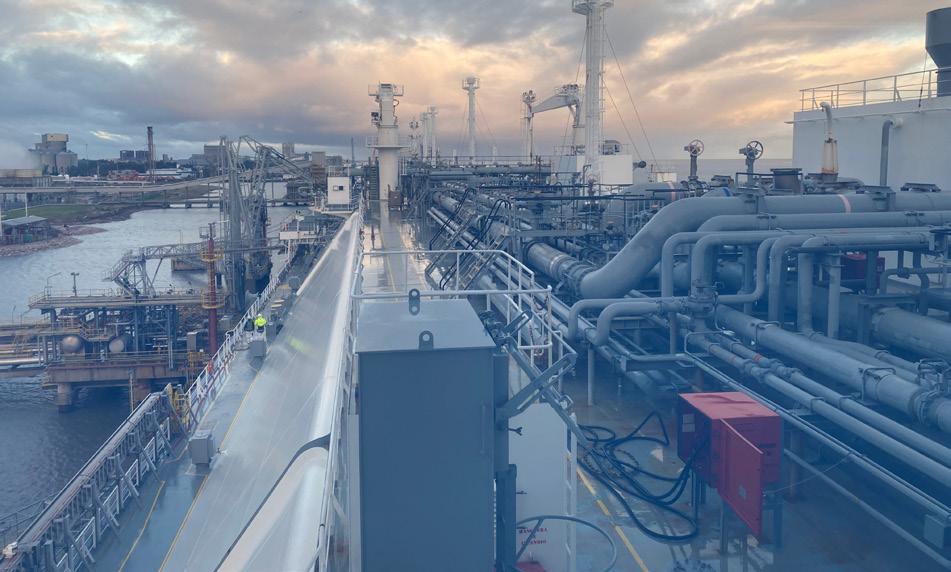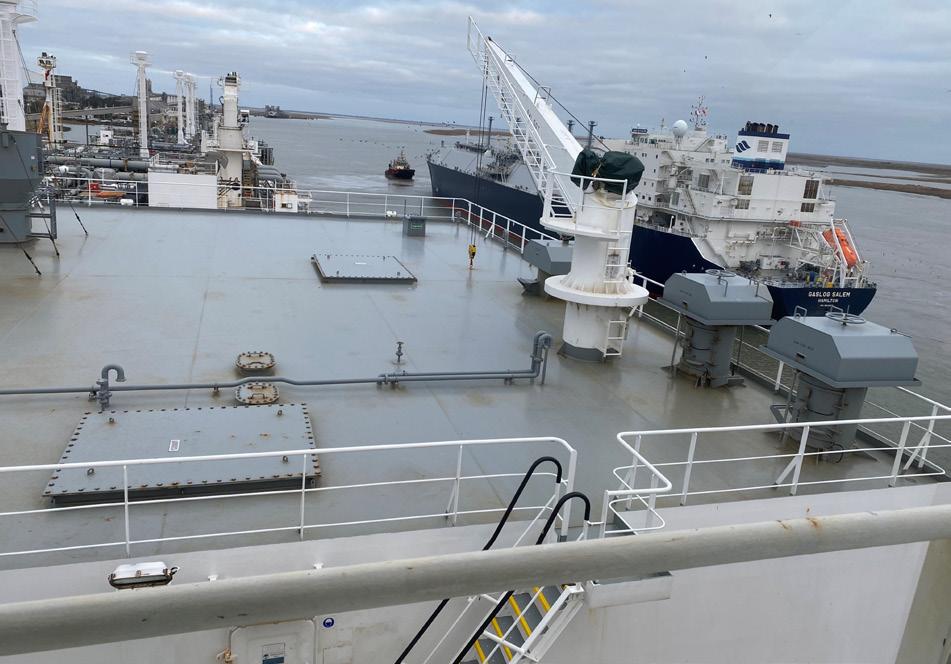
7 minute read
Upgraded by design
Andrew Stafford, Technical Director, Trelleborg Marine & Infrastructure, UK, describes the evolution of infrastructure for LNG transfers, focusing on how jetty designs are being readdressed so they are suitable for future applications.
From the growing need for short-term storage to meet demand in order to weather the energy crisis, to the growing global climate challenges necessitating cleaner energy choices, changes in market dynamics are driving evolution and growth within LNG transfer technologies and practices. As a result, jetty design must adapt to ensure facilities are fit-for-purpose to meet not only today’s demands in a safe, efficient, cost-effective, and sustainable manner, but also those posed in the future.
Short-term storage and the redesign of energy networks
Operators are improving existing infrastructure by upgrading jetties using FSUs as semi-permanent storage structures and using ship-to-ship (STS) transfers more regularly to meet demand. However, whether upgrading existing or planning for new infrastructure, it is vital that operators consider the inclusion of a contingency that facilitates the speedy implementation of additional storage by considering the potential role of FSUs at the engineering stage of the jetty upgrade or design process. This requires the consideration of the current and future requirements for a potential STS arrangement, which may help to establish specification requirements such as stronger piles and enhanced mooring capabilities. Once the requirement to increase capacity is agreed, the gaining of permits, the building of onshore tanks, and other construction will take time. Utilisation of the FSU model solves the immediate problem and provides a faster route to operation while more permanent solutions are being prepared. Additionally, in the coming years there are likely to be many LNG carriers, typically steam turbine-powered, reaching the conclusion of their trading life that can be repurposed as FSUs. For example, Qatargas recently purchased 10 of its previous charter fleet to help bridge the existing supply and demand gap.1 Further emphasising the need for a more strategic approach to securing the reliable and flexible supply of gas, it is widely expected that the rise in short-term, semi-permanent, localised storage of LNG seen throughout 2021 is set to continue. For instance, Mitsui OSK Line’s Q-Max sized FSRU has found interim employment in Singapore as it awaits deployment to a long-term contract in Hong Kong.2 Gas supply networks are also being reviewed and, where necessary, redesigned due to the impact of the conflict between Russia and Ukraine. For example, while Germany receives approximately 42 billion m3 of gas from Russia, the drive for independence from Russian gas supply means this may soon be turned off and so must be sourced from elsewhere.3 There is, however, some movement already happening in terms of the redesign of some supply chains. For instance, 75% of all US LNG cargoes delivered in March 2022 landed in Europe and Turkey, compared with approximately 44% in March 2021.4 Additionally, with no LNG terminal capacity, the German government has released €3 billion to acquire FSRU charters and associated simple gas take of jetties, which includes the signing of deals for two Hoegh LNG and two Dynagas FSRUs.5

Decarbonisation through LNG
The growing global climate crisis and the need to meet sustainability goals in more mature global markets are driving infrastructure changes. As the transition towards a net zero economy gains momentum and LNG becomes increasingly cost-competitive, the demand for LNG and its related infrastructure will only increase. What is more, many shipping lines are decarbonising their operations through the use of LNG as fuel, as it contains 24% less carbon per unit of energy than conventional marine fuels. Harvey Gulf International Marine LLC has partnered with SailPlan, an emissions monitoring and optimisation platform that combines the real-time engine, fuel, and navigational data from vessels, with the weather, mapping, infrastructure, and traffic data, to benchmark, optimise, and report
on fleet emissions. The result is a carbon saving of up to 29% across its LNG supply vessel fleet.6 The shipping company has also started to embrace bio-LNG (a blend of recaptured pig and dairy farm gas combined with conventional fossil LNG), running one of its platform supply vessels solely on battery power and bio-LNG.7 It is therefore essential that when looking to build new or develop existing facilities, consideration is given to local gas production to establish the potential to import other sources of gas such as agricultural or even synthetic. What is more, if a new facility intends to store hundreds of thousands of cubic metres of imported liquefied gas and wants to backload a specific volume of gas to a bunker vessel locally, it is vital that the required infrastructure is considered and put in place during terminal design.
When it comes to jetty upgrades, it is important to ensure infrastructure can also successfully accommodate smaller ships – an increasingly important option to meet the growing demand for LNG. Therefore, rather than simply look at investments across fixed infrastructure, such as fenders and specialised loading arms for larger vessels, thought must be given to how infrastructure can be flexible for smaller vessels too.
Leveraging terminals as distribution hubs
It is becoming increasingly important for many terminals to export both domestically and internationally, operating as distribution hubs. For instance, New Fortress Energy is taking large FSUs and distributing LNG from smaller vessels to supply multiple customers in smaller quantities accordingly.8 When building a terminal, it is vital that operators look at the facility’s surrounding infrastructure to establish potential additional ways in which it can expand its network of supply, whether by marine transfer or even by loading and shipping ISO containers to different local users. For example, in ports such as Jacksonville, Florida, US, ISO containers are loaded and shipped to Puerto Rico via LNG-fuelled ships. This demonstrates how, when looking at terminal infrastructure, for many operators today it is not enough to simply establish how much LNG they can receive or even produce. The volume it can also look to export and supply to the local grid by unconventional means must also be considered. While of course not all terminals are built to supply local grids, it is important to consider the potential ways in which LNG can be remonetised.

Figure 1. It is vital that operators, whether upgrading existing or planning for new infrastructure, look to LNG solutions that offer configurability, compatibility, and flexibility.
Figure 2. Changes in market dynamics are driving evolution and growth within LNG transfer technologies and practices.

Optimising berth availability
Given the evolution and growth of LNG globally, the maximisation of berth availability is crucial. Therefore, it is important to identify and put in place contingencies for infrastructure downtime or even failure, to ensure optimisation of safety and performance. Some terminals that utilise fixed-fender solutions have also completed design studies to accommodate a contingency for back-up pneumatic fenders in the event of fender damage or during maintenance. Additionally, some terminals have also considered the utilisation of hose transfer systems as a loading arm contingency. In the event of a marine loading arm failing, many do not carry a spare onsite or have the lifting capability to change out an arm, which can then take between nine and 12 months to replace. This, coupled with the fact that one loading arm failing signals the potential for others with similar operation and maintenance histories to do likewise in the near future, could have a significant negative impact on terminal efficiency and performance. Adding simple pipework tie-ins allow these hose transfer systems to be viable and keep terminals operating when ordinarily they could be out of production.
Terminals must have contingencies in place to ensure they remain operational, even in the event that substantial assets or infrastructure are not available.
Looking ahead
The global LNG infrastructure market is expected to witness significant growth in the near future. However, in order to respond to the various challenges and opportunities, infrastructure must be able to keep up with demand. Therefore, it is vital that operators, whether upgrading existing or planning for new infrastructure, look to LNG solutions that offer configurability, compatibility, and flexibility to not only meet their bespoke operational requirements today but also tomorrow.
References
1. Tradewind News, 2022. 2. Tradewind News, 2022. 3. IEA, 2020. 4. SP Global, 2022. 5. Reuters, 2022. 6. Offshore Energy, 2022. 7. Offshore News, 2022. 8. OE Digital, 2022.










